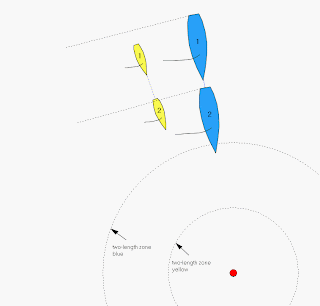Two-Length Zone The area around a mark or obstruction within a distance of two hull lengths of the boat nearer to it.
Two lengths is very hard - with any measure of accuracy - to judge. The best place to do it, is perpendicular to the approaching boat and even then it's a split second, when there's any kind of breeze.
For sailors, sitting at the helm at the back, it's even harder to judge when the bow reaches that specific point. The border of the two length zone is in practice more like a wide band then a line.
Because the positions of the boats - with or without overlap - determines right of way in the subsequent mark rounding, it is a skill to get it right. Sailors usually sail the same boat in many regattas, so they have the advantage of practice. After a couple of events and enough situations, they know. Don't just look at this only when in close proximity of others, no, practice also when you are alone, say it out loud and let your crew do the same.
Furthermore the rules have a way out, when there's doubt - which is almost automatic when two parties disagree. Unless there's a credible witness who was in a right position to see, the jury will use rule 18.2(e) which in short says: when in doubt, it is not so.
If in the leg before the mark rounding, boats were clear ahead / clear astern and there is doubt if the overlap was established in time, this rule says it wasn't. If there was an overlap for some time, before the critical entrance of the two-length zone, and there is doubt about whether that overlap was broken, again rule 18.2(e) dictates it wasn't.
Don't think this is something for the protest-room alone. The same rule should be applied on the water. If you have doubt that you got your nose in on time, better assume you didn't and keep clear accordingly.
In regattas with one design classes the distance from the mark is fixed. But for different length boats in the same race area who have to round the mark at the same time, the distance is varied. Then the second part of the definition is also very critical and can make a great deal of difference when rule 18 begins to apply.
The two following two diagrams illustrate that, between two boats where the blue one is twice the length of the yellow one.


A mark is usually small and has round circumference. The two-length zone is therefore also round. But obstructions come in all shapes and sizes. Please remember that the two-length zone has the same shape and is seldom round.
TSS - the program to draw these diagrams, does not (yet) have that ability. All two-length zones are calculated from one point, regardless of the size of the obstruction.

0 comments:
Post a Comment